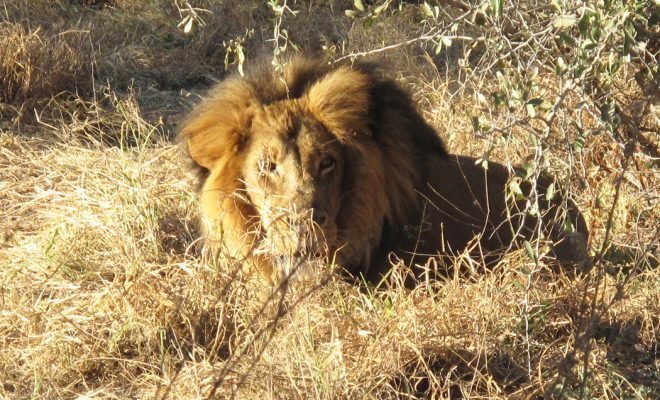 "BDF Wildlife Training Area" courtesy of [US Army Africa via Flickr]
"BDF Wildlife Training Area" courtesy of [US Army Africa via Flickr]
Energy & Environment
Lions and Tigers and Bears: Inside the Exotic Animal Trade
Much controversy has arisen over Cecil the lion, who was killed, skinned and beheaded by a dentist from Minnesota looking for a trophy. The slaying of a protected and revered animal drew criticism from national media and social media and forced the man responsible into hiding. However, this is just one example of an exotic animal killed for its skin, head, or body parts. These unique species are often smuggled or illegally traded, transported through grueling conditions, and forced into unnatural environments . Read on to learn about the exotic animal trade–from hunting to breeding and trafficking.
Live Animal Trading
Traded animals come from a variety of sources, including from being captured in the wild to being sold as surplus from zoos or zoo-like institutions. These animals are then sold over the internet or through live auctions. Both marketplaces are poorly regulated, although auctions are regulated through the Animal Welfare Act and any state regulations that might also apply.
In addition to acquiring these animals through smuggling, Americans began breeding their own exotic animals beginning in the 1960s and 70s. Due to the high profitability of selling these animals, breeding has become a successful industry. The increased value often comes from restaurants seeking alternative types of meat or for hides. High import taxes, which have reduced poaching, also make breeding a profitable option for American sellers who can potentially benefit from decreased competition and expenses.
Wherever animals are bought and sold, they often face poor treatment from their new owners, even unintentionally. For companies, this is frequently a result of economics–it is usually cheaper to let an animal die or not treat it than it is to pay for a veterinarian. In the case of private individuals, animals are often bought without the knowledge of how to care for them, particularly in the case of exotic species. Unsurprisingly, this can lead to a high rate of abnormal behavior, sickness, and even death amongst animals living in new environments.
Perhaps the most gruesome and public incident occurred four years ago in Zanesville, Ohio. In 2011, a caretaker of large exotic animals released many of them before killing himself. Most of the animals were then subsequently killed by authorities, including endangered species such as lions, tigers, bears, and wolves. In this case, local authorities unfamiliar with how to trap these exotic species resorted to killing them in order to protect the public.
Transporting animals illegally also presents significant challenges. When shipping animals to evade authorities, many of the animals transported actually die in transit. While exact figures are not entirely clear and are often exaggerated to drum up action, the laundering of animals in ways such as the one used by a man who strapped lizards to his chest when passing through LAX can lead to high mortality rates. The following video gives an inside look into the exotic animal trade:
Fur and Pelt Trade
In the Wild
Various animals and plants are hunted for a number of reasons. However, continued hunting has left many of these animals and plants at endangered levels or very near to it. Perhaps the most affected are large mammals, as well as sharks and whales. While these animals can be hunted for meat, more often they are hunted for sport, either for the head or other body parts.
While it is illegal to hunt these animals without a permit, if the hunter is willing to pay enough he or she can hunt virtually every animal on or approaching the endangered species list; the idea is the money spent killing them can then be used in protecting healthier members of the same species. This includes lions and even black-horned rhinos, one of the most endangered species in the world. In fact the right to kill one such rhino last year, a rhino past his effective breeding age, generated 350,000 dollars for Namibia to use for its conservation efforts.
In Captivity
As an alternative to the wild, exotic animals are also bred on farms. These farms often exist for the express purpose of producing furs. The value of animal furs cannot be understated in history, as it was a main source of development for Europeans in modern-day North America and Russia. Currently, most of the furs used for clothing come from animals raised on fur farms. The United States is home to many such places, however, China is quickly dominating more and more of the fur farm market. The following video provides some details on the lives of animals raised on fur farms:
Aside from raising animals on farms for fur, they are also being bred on ranches. In this case, for half a century exotic animals have been brought up in ranches in Texas with the express purpose of hunting them. In the view of those running such ranches, this allows hunters to get out their desire to hunt these animals in a controlled setting and thus reduce the need for killing them in the wild. The video below looks at the ranches in Texas:
Method to the Madness
The reasons why people kill these exotic animals include use in religious ceremonies, for food or clothing, and even to use them as trophies. The most common underlying motive, though, seems to be for profit. Killing most animals is allowed by governments for the right price and with the proper licensing. Walt Palmer, the dentist who shot Cecil the lion for example, reportedly claimed to have paid more than $50,000 dollars and obtained the proper permits to kill the animal. The return on this investment–whether it be a trophy, skin, or head–to the hunter can more than make up the cost in hunting, especially if the hunt is orchestrated illegally.
Tigers, for example, can fetch as much as $15,000 for their skins. In fact, the profitability of killing and selling animals is so great that is has become the sphere of organized crime. These professional criminals employ every means from using helicopters to night-vison goggles to body armor to kill their prey.
Regulating the Animal and Fur Trade
According to the Michigan State Animal Legal and Historical Center, while few states require anything more than permits for hunting, the United States has several federal laws that seek to prevent the killing of animals for fur, including the Lacey Act, the Marine Mammal Protection Act, the Fur Seal Act and the Endangered Species Act deal. Additionally, the Fur Products Labeling Act requires precise labeling on clothing of exactly what type of fur is being used. There is also the Dog and Cat Fur Protection Act, which prevents using fur from those animals in clothing. However, these laws are ultimately aimed at stopping the fur trade from wild animals, not those bred on fur farms.
The U.S. government sees fur farms like most other farms, leaving them under the authority of the Department of Agriculture. While the United States has laws against animal cruelty, there are very few other protections in place. However, some other countries have much stricter fur regulations. In fact, the UK, Austria, and Croatia ban fur farms entirely.
Conclusion
Killing and illegally transporting is a problem, but a problem that begs the question: how much more can be done? More laws and agencies can continue to be created with the goal being to stop this industry, but like with drugs or gambling, after a while more restrictions stop having any more effect. Existing laws have been somewhat successful, particularly using the money for the right to kill animals to reinvest in protecting them, a fact even acknowledged by the World Wildlife Fund. Furthermore, like those industries, these laws fail to get at the root of the problem: the demand for these animals and their skins. No matter how many poachers or hunters get arrested there will always be someone else to take their place, especially when it offers a lucrative job for a person in need.
There are several alternatives to the hunting and poaching of these animals in the wild, like fur farms and ranches. However these also draw a great deal of criticism which puts hunters in a somewhat difficult position where they face criticism for hunting animals in the wild and on ranches whose sole purpose is hunting.
Either way, while major news outlets and social media platforms crackle with indignation over the death of one lion, it appears if people at times lose track of more important issues. While high-profile events like the killing of Cecil the lion gain a lot of attention and may even spark public outcry, focusing on individual cases may cause people to lose sight of the issues with the animal trade as a whole. The industry is likely to continue as long as people have a desire to hunt, the price is right, and society lacks a proper understanding of how these animals are treated.
Resources
Born Free USA: The Dirty Side of the Exotic Animal Trade
Michigan State University Animal Legal & Historical Center: Fur Production and Fur Laws
Chicagoist: Minnesota Trophy Hunter Accused of Killing Beloved Lion
Discover News: Trophy Hunting Is There Any Benefit to Conservation?
USA Today: Fury Over Cecil the Lion also Sparks Race Controversy
PETA: Inside the Exotic Animal Trade
The Center for Consumer Freedom: FBI Anti-terror Unit Investigated PETA
USA Today: Years later Effects of Exotic-Animal Tragedy Still Felt
Dr. Steve Best: Top Five Animals that Face Extinction Satisfying Human greed
CBS News: Can Hunting Endangered Animals Save the Species?
National Wildlife Federation: Overexploitation
List Verse: 8 Endangered Species Still Hunted
Priceonomics: The Exotic Animal Trade
UC Small Farm Program: Exotic Livestock
Humane Society: Dangerous Exotic Pets








Comments